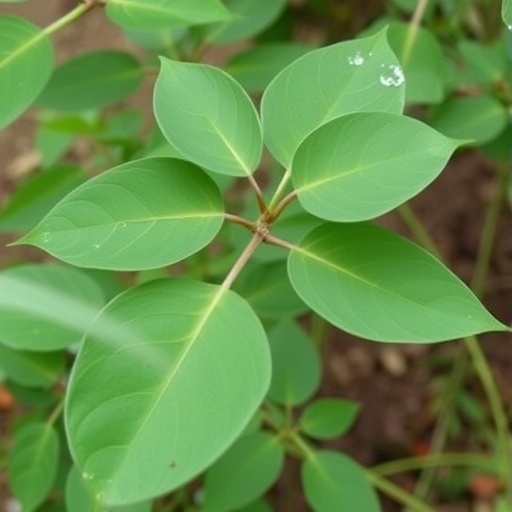In a groundbreaking study published in Discover Plants, researchers Tippani, Porika, and Thammidala have introduced a compelling analysis on the clonal fidelity of Pterocarpus marsupium Roxb. plantlets. This tree species, famed for its numerous ecological and economic benefits, is increasingly the focus of both conservation efforts and agricultural applications. The direct somatic embryogenesis method utilized for regenerating these plantlets represents a pivotal advancement in horticulture, offering unique opportunities for improving plant propagation strategies.
The research centers on employing Inter-Simple Sequence Repeat (ISSR) markers to ensure the genetic integrity of the plantlets. Clonal fidelity is paramount in any plant propagation technique, especially when aiming to maintain the desirable traits of the parent plant. The significance of this study lies in its potential to reassure researchers, horticulturists, and conservationists that the plantlets produced through these advanced techniques are true-to-type—meaning they retain the same genetic characteristics of their progenitors.
Utilizing ISSR markers provides researchers with a powerful tool for genetic fingerprinting in plants. This molecular technique is particularly effective because it amplifies regions of the genome that are highly polymorphic. By analyzing the genetic profiles of regenerated plantlets against those of their source materials, scientists can identify any discrepancies that might indicate a loss of clonal fidelity. The findings of this study are likely to have far-reaching implications for the biotechnology industry, as they underscore the importance of rigorous validation methods in plant regeneration protocols.
Aside from the scientific rigor involved, the study cast a spotlight on the broader implications of ensuring genetic consistency in plant propagation. Maintaining clonal fidelity is essential not only for the efficiency of agricultural practices but also for biodiversity conservation. When plant species are propagated accurately, it aids in preserving genetic variance, an increasingly critical consideration given the global challenges posed by climate change and habitat loss.
Equally important is the potential application of this research in scaling up the propagation of Pterocarpus marsupium, which is listed as a threatened species in certain regions. Given its value in timber production, medicinal applications, and soil conservation, there is an urgent need to enhance propagation methods. This research provides a pathway for sustainable forestry practices by ensuring that regenerated populations are genetically consistent with naturally occurring ones.
The innovative aspect of the study resides in the rigorous methodology employed. The researchers meticulously sampled various plantlets regenerated through direct somatic embryogenesis. They carefully documented the processes, which included tissue culture techniques and subsequent ISSR marker analysis. This level of detail is crucial for others in the field who aspire to replicate or build upon the findings presented in this study.
Moreover, the article sheds light on the technical challenges encountered during the research. Establishing reliable tissue culture systems is often fraught with complications, such as contamination and somaclonal variation. Learning from these obstacles, the authors present solutions and best practices that can aid future researchers in navigating the nuanced landscape of plant tissue culture and genetic analysis.
The ramifications of this study extend beyond academic circles and into practical applications in agriculture, forestry, and conservation. As the demand for sustainable practices increases, insights derived from such genetic fidelity studies will inform policies and practices that prioritize ecological resilience. The commitment to maintaining the genetic integrity of regenerated plant populations reflects a growing awareness of the interconnectedness of human activities and environmental health.
As the study gains traction, it is likely to inspire more research initiatives that focus on genetic fidelity and conservation. The collaborative nature of this work—incorporating expertise from various sub-disciplines within plant biology—demonstrates the potential for interdisciplinary approaches in addressing pressing environmental challenges. If replicated across other species, these techniques could revolutionize how we understand plant propagation and conservation.
In summary, Tippani, Porika, and Thammidala’s work is a significant contribution to the field of plant regeneration and conservation biology. By offering a detailed analysis of clonal fidelity using ISSR markers, it provides a foundation for future explorations into plant tissue culture techniques and highlights the importance of genetic integrity in sustainable practices. This study serves not only as a scientific accomplishment but also as a call to action for researchers and practitioners to innovate boldly in the face of global ecological challenges.
As this study resonates within scientific communities and beyond, it inherently illuminates the integral role that rigorous research plays in achieving sustainable solutions for our planet’s diverse botanical heritage. With advancements such as these in plant regeneration techniques, there is renewed hope for the preservation and propagation of vital species like Pterocarpus marsupium.
In conclusion, the future of plant propagation is bright, fueled by the promising findings of this study. The integration of advanced molecular techniques into traditional practices has opened up new avenues for ensuring that our agricultural systems not only thrive but do so with a keen eye for ecological harmony. Researchers and practitioners alike are encouraged to take inspiration from this work, pushing the boundaries of what is possible in the realm of plant genetics and conservation strategies.
Subject of Research: Clonal fidelity analysis in Pterocarpus marsupium plantlets.
Article Title: Clonal fidelity analysis using ISSR markers in Pterocarpus marsupium Roxb. plantlets regenerated through direct somatic embryogenesis.
Article References:
Tippani, R., Porika, M. & Thammidala, C. Clonal fidelity analysis using ISSR markers in Pterocarpus marsupium Roxb. plantlets regenerated through direct somatic embryogenesis.
Discov. Plants 2, 241 (2025). https://doi.org/10.1007/s44372-025-00319-9
Image Credits: AI Generated
DOI: 10.1007/s44372-025-00319-9
Keywords: Clonal fidelity, ISSR markers, Pterocarpus marsupium, somatic embryogenesis, plant propagation, conservation biology.




